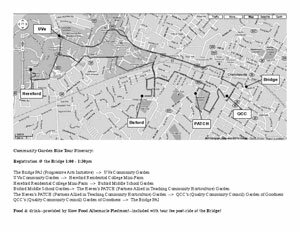GOATING GREEN- 16 Tales of Local Backyard Innovation
Bamboozled?

Kevin Cox
PHOTO BY COURTENEY STUART
Bamboo sometimes gets a bad rap as an invasive species that'll take a mile of your yard if you give it an inch, but bamboo gardener Kevin Cox says the plant's just misunderstood. In addition to its utility as a green building material that regenerates faster than traditional hardwoods, the young shoots can be cooked and eaten. Controlling it is key, says Cox, who maintains 18 varieties of bamboo in his own yard in the Woolen Mills neighborhood. The trick, he says, is cutting the rhizomes– the runners that spread just an inch or two underground and off of which come roots and shoots. Using a pick axe, Cox digs a trench around the desired perimeter each late summer to early fall and severs the rhizomes, then knocks down any undesired new shoots that come up.
"I control it and it doesn't go into the neighbors's yard," he says.–Courteney Stuart
Green-mobile
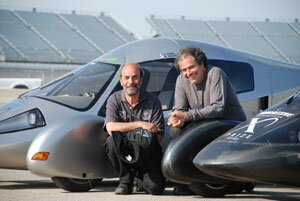
Edison2's Ron Mathis (left) and Oliver Kuttner
PHOTO COURTESY EDISON2/Brad Jaeger
If your home's gone green, the next place to look might be the driveway. And if Oliver Kuttner has his way, you could have a vehicle that gets 100mpg parked there sometime in the next few years. Kuttner and his Edison2 team won $5 million in the Progressive Automotive X Prize on Thursday, September 16 with their Very Light Car. Weighing around 700 pounds and designed from scratch and hand-built with recyclable parts, many of which were manufactured in Lynchburg machine shops, the car runs on a combustion engine. Kuttner's next focus is developing the Very Light Car for mass production with a target price of under $20,000.
Winning the X Prize, a thrilled Kuttner promises, "is only the beginning." –C.S.
Harvest Art at The Bridge

PHOTO BY TOM DALY
"It's the perfect place to have a garden," says Blue Ridge Backyard Harvest co-founder Guinevere Higgins, looking around at a scattering of cardboard tubes behind The Bridge Progressive Arts Initiative gallery. "We've had our eye on it for awhile."
The pairing of The Bridge, one of the leading communities supporting local art initiatives, with BRBH, the area's newest backyard gardening consultants, is decided way to welcome fall to Charlottesville. In past years, The Bridge, has hosted "Harvest Month" in October, with different events and exhibits curated with emphasis on local farming and gardening programs. This year, BRBH has set up an outdoor exhibition of their innovative planters. Using tubes donated by Allied Concrete, BRBH will grow fall crops– lettuce, cilantro, beets– in cylinders of varying heights by covering one end with mesh and filling the tube with wood chips and 4-6 inches of soil and compost.
"In October, [The Bridge] is hosting two dinners that Rick Easton of Sub Rosa Bread is doing the cooking for," explains Mike Parisi, co-founder of BRBH. "They'll be Mexican-themed, and the point is to sit down, take your time, eat dinner, have conversations, slow down."
While a majority of the crops grown will be used in the dinners, the rest will be donated to Bridge volunteers– and, with the installation up through November, the entire concept, from seedling to table, will be art. –Stephanie Marie Garcia
Roof reservoir

DRAWING COURTESY BILL ATWOOD
First the green roof was the conservation rage. Architect Bill Atwood takes it up a notch with roof reservoirs. "The next green is blue," says Atwood. "It's all about water." Atwood's 10.5 West Main project at the site of the former Under the Roof will come with reservoirs and permaculture–- capture your own water, grow your own food. And in a community with a years-long debate about future water supply, Atwood advises putting the new reservoir on the roofs of Charlottesville. "It would cost less," he says, "and it's all here." –Lisa Provence
Spray foam, earn tax credits, too
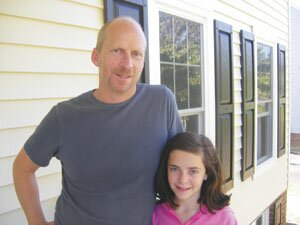
PHOTO BY LISA PROVENCE
When the siding and windows on Jim Bain's 1980s house in Raintree needed to be replaced, he further sealed the deal with spray foam in the attic and basement. The spray foam portion of the job cost $2,500–- but the good news is a $1,500 energy tax credit for work done by the end of the year, and reduced electric bills for years to come. And daughter Chloe, 9, got new windows in her room. Bain's upgrade was done in July, and while his most recent electric bill includes only a partial month with the new windows and foam, it moved him into the "most efficient" category in his neighborhood. –L.P.
Recycle your house

PHOTO BY KIM VEILLON
Maybe you've raised your family in your classic '60s rancher– or classic 19th-century farmhouse– and want to stay there in your senior years without blowing your fixed income on the electric bill or falling in the tub. That's what Builderfish's Todd Hawkins and Jonathan Fishbeck are talking about when they say recycle your house to meet your current life cycle. For about the price of a year in a nursing home, why not improve the energy efficiency of your aging abode and make it ADA accessible for spending those golden years in the comfort of your own home? –L.P.
Market stamps

Stamp it at City Market
PHOTO BY HAWES SPENCER/Brad Jaeger
Eating local's great and all, but it's long been a luxury for those with expendable income who can shop wherever they choose– and sometimes pay top prices. This year, however, that changed as City Market began accepting food stamps and government subsidy food debit cards– the value of which is then doubled with tokens from the City.
"I was happy to know that I could keep those funds within the city that I live and to be able to provide my family with fresh food," says one shopper who used her government debit card on a recent City Market foray and who asked that her name not be used. –C.S.
Coop co-op
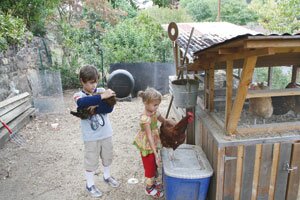
Eight-year-old Briton and four-year-old Evelyn Grimm are expert chicken wranglers.
PHOTO BY COURTENEY STUART
In spring 2009, four north downtown families built a coop and filled it with chickens. A year and a half– and hundreds of eggs– later, "it's working out great," says Gillian Grimm, whose husband, architect Will Grimm, designed the coop to be weatherized, green (it collects rainwater!), and predator proof. It currently houses 11 chickens and each of the families takes turns collecting eggs– it works out to about a dozen per family each week– with shared coop cleaning responsibilities as well.
"It's about the same amount of work as having a cat with a catbox," says Grimm, who says the chicken experience has been a bonding one for children and parents alike.
Apparently, neighbors who get eggs together, stick together. –C.S.
How to: Fall-ify your Chickies
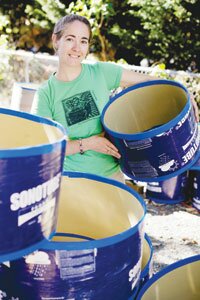
PHOTO BY TOM DALY
"There's not a lot of seasonal difference for chickens– it's not like a garden in that way," explains Charlottesville League of Urban Chicken Keepers founder Guinevere Higgins. "But eventually it will get colder."
As an avid "chicken enthusiast", Higgins gives chicken owners her top tips for ensuring your birds will have a fruitful fall:
-Make sure your coop is properly winterized. Proper ventilation (i.e., not full of holes) is key.
-Roosts should be 2-4 inches wide to prevent frostbite on little chicken feet.
-As the grass dies and bugs fly south, diet will change– so make sure to supplement bird diet with food scraps and protein (chickens, contrary to popular belief are not vegetarians).
-As the light fades and the day gets shorter, chickens will start laying less– a cost-efficiency point to keep in mind.
-Let your chicken loose in your garden– they'll eat bugs, clear out unruly beds, and add crucial fertilizers to the soil when you're ready to put your beds to rest for the year.
-Another Charlottesville chicken myth: the city ordinance about chickens only mandates that they be enclosed–- the ordinance says nothing about the number of chickens you can keep. So while your neighbors might not like you, you are allowed to house as many chickens as your backyard can hold. –S.M.G.
Power down
It might seem counterintuitive for a company that sells power to try to get you to use less, but that's just what Dominion's doing with several initiatives. The first: a bimonthly addendum to your bill that shows how your home stacks up with similar houses nearby. The graphed data is being sent to half of this area's 50,000 Dominion powered homes, which have been equipped with new "smart meters" that allow the energy company to get real time data.
"What we're trying to find out," says Dominion's Alison Kauffman, "is if we empower you with your data– does the customer feel empowered to make changes?"
The second initiative is known as the Smart Cooling Rewards program in which the power company uses a specially installed sensor to automatically turn off A/C units in intervals during peak hours. While Kauffman says participation may not result in a decreased bill, participating customers are given a $40 voucher as a reward.
Finally, says Kauffman, Dominion has partnered with various local stores including Wal-Mart, Sam's Club and Lowe's to discount CFL bulbs, which use far less energy and last longer than traditional bulbs. –C.S.
Shady deal

PHOTO BY LISA PROVENCE
A tree on the southwest side of your house is another way to reduce the A/C bill over the years. Ivy Corner's Judy Olson recommends zelkova serrata, a vase-shaped variety brought in from Japan after Dutch elm disease devastated the American elm. "I have two of them over my porch," says Olson. "They provide shade in the summer from the west side, and in the winter when they've dropped their leaves, they let in sun." Better news: the leaves are small and don't make a big mess in the fall. This medium-fast grower can reach 35 feet tall– or more. –L.P.
Plugging the leaks
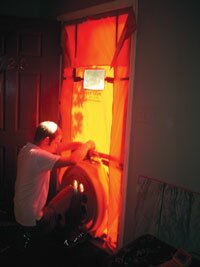
PHOTO BY LAURA FIORI
The blower-door test is a key part of the home-energy audit to find out just how leaky a house is. "A lot of homeowners want to improve their homes' energy efficiency, and don't know where to start," says Key Green Energy owner Laura Fiori. "We make a written report of recommendations in priority order so the homeowner will know which upgrade will save the most energy." The audit can run between $350 and $600– but after repairs, if energy costs improve by 20 percent, the house can by certified by nonprofit Local Area Energy Program. "It can increase the value of the home," notes Fiori. [Wilson Ratliff pictured.] –L.P.
Five Tips for Fall-Proofing Your Garden
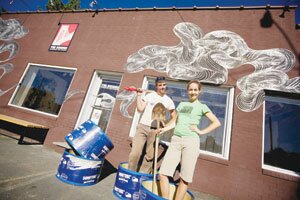
PHOTO BY TOM DALY
Top tips from Blue Ridge Backyard Harvest:
1) Do a soil test– the winter is a great time to build your soil if you have any deficiencies.
2) Grow a fall crop and start from transplants. Kale, chard, lettuce, beets, and carrots are your best options.
3) Grow a cover crop or mulch your garden so it's not bare during the winter time– it will keep your soil in place so it doesn't blow away. Both these options will keep your nutrients in place.
4) Build a cold frame (a raised bed, with a top covered with glass or plastic)– this will extend your season and allow you to grow plants longer into the colder months.
5) Read up, process what happened in your garden over the past season, and plan for the next season! –S.M.G.
Intensive gardening for fun and profit
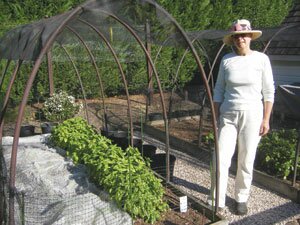
PHOTO BY LISA PROVENCE
How does master gardener Diane LaSauce love her organic raised beds? Let her count the ways: Improved crop quality, top-notch soil, fewer critters, great water retention, and easy on the back. And they look good, too. LaSauce places buckets around her beds to capture rainwater, a method that's easier for her to manage than the rain-barrel route. Her beds pack enough produce to make her a regular at the City Market selling her Free Union Produce and Gourmet Edibles, like the chive-artichoke-walnut pesto. –L.P.
No kidding

PUBLICITY PHOTO
Goats offer milk, cheese, fertilizer, companionship, and weed-removal. And thanks to a unanimous September 7 City Council vote, they became legal in Charlottesville. Previously, goats— along with swine and sheep— were banned. And that was just fine with St. Clair Avenue resident Naomi Roberts. "Farm animals belong on the farm, not in city yards," said Roberts. But fellow speaker-to-Council Clint Sherrill opined that goats are better than dogs. "If you're in favor of dogs," he said, "you should have no problem with goats." The local chapter of a group called the Goat Justice League spearheaded the law, which limits residents to three goats, which must be dehorned, under 100 pounds, and neutered if male. –Hawes Spencer
Calling all Bikers! Calling all Gardeners!
"We had been doing the garden tours, which is awesome," explains Charlottesville Open Garden Project co-founder Rachel Greer. "But I think there is a certain limitedness about it– there is a lot of other gardening happening in this town, all these great community gardens that no one really knows about."
While the Cville Open Garden Project has found success invading the home gardens of accomplished and innovative local gardeners, co-founders Greer, Mike Parisi, and Guinevere Higgins craved a tour with a bit more interaction for the tourist. With the plethora of community gardens thriving around town, the Open Garden Project found a way to bring visibility to the communal garden by bringing together avid gardeners and bikers together to raise awareness. Their October tour will include five local gardens– the UVA Community Garden, Hereford Residential College Mini-Farm, Buford Schoolyard Garden Project, The Haven's PATCH Garden, and QCC's Garden of Goodness.
"There's a totally different kind of goal for community gardening– a lot more at play in terms of who you're feeding, how you're feeding them," says Greer. "It's really important to see how community gardens are practiced all across town, and to see them in relation to one another."
Biking was a natural vehicle for such a far-flung tour. Greer, Parisi, and Higgins found themselves interested in the various ways the City of Charlottesville has been attempting to make the area more bike-friendly, and found warm reception from officials and community groups to their proposed cross-town tour. The combination of biking and gardening is a multi-pronged approach at creating a healthy, informed, active community, according to Greer.
Reservations for the tour are recommended, and more information can be found at cvillebiketour.blogspot.com. –S.M.G.
#
